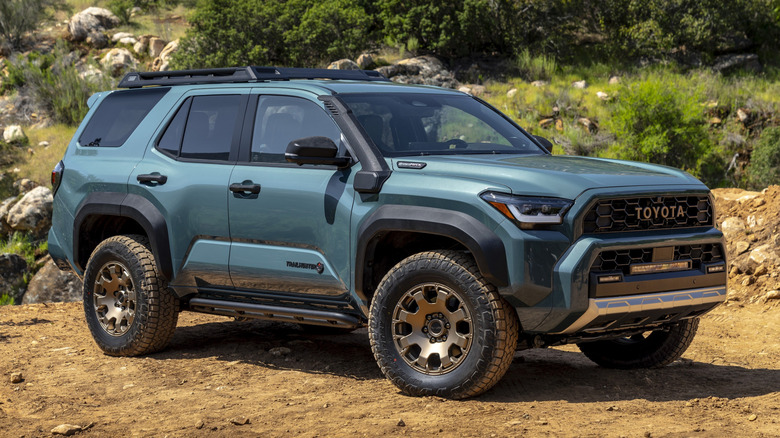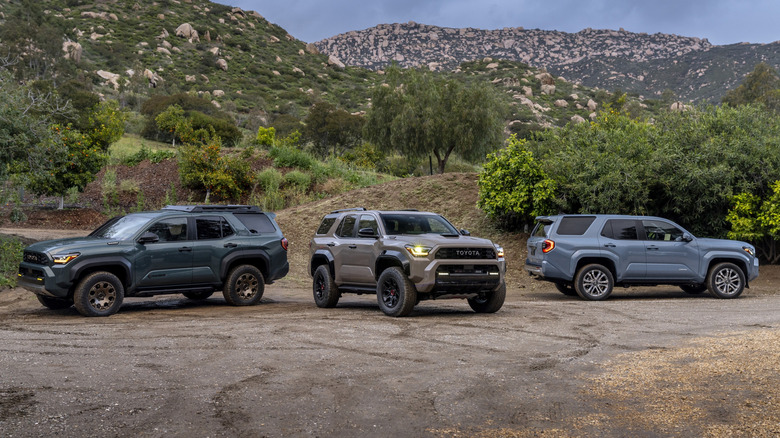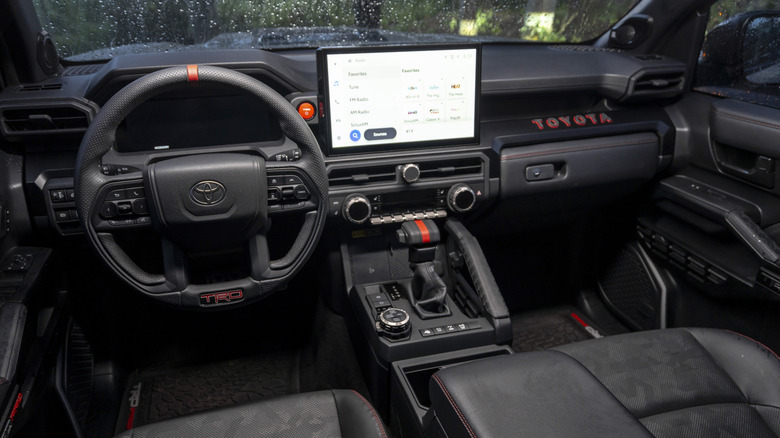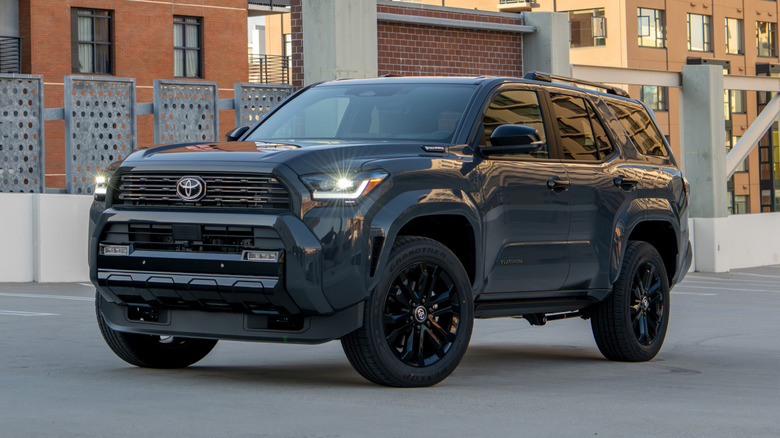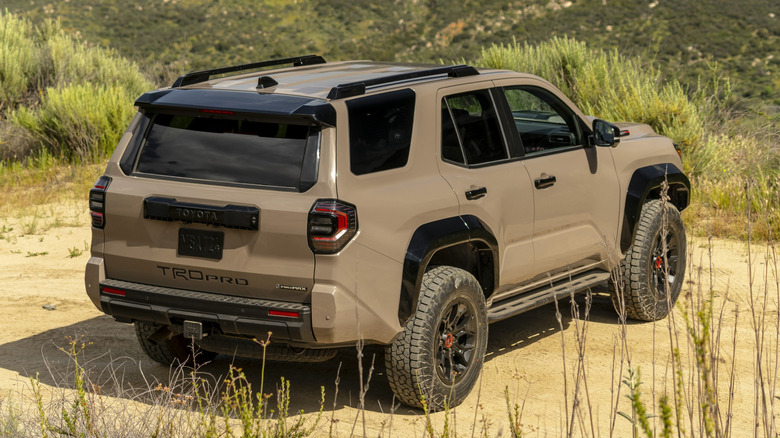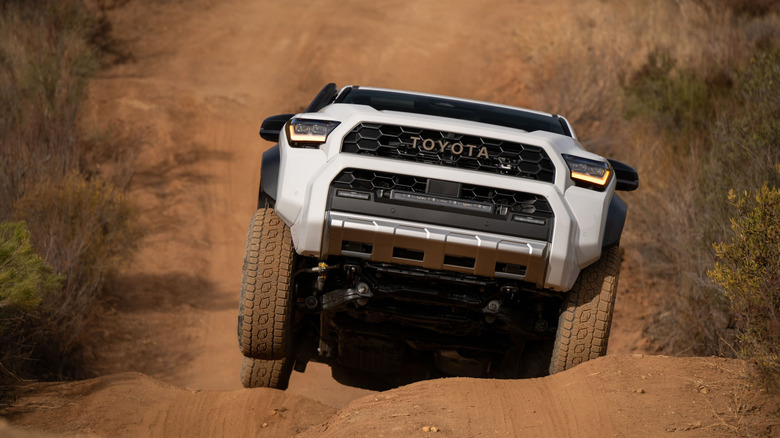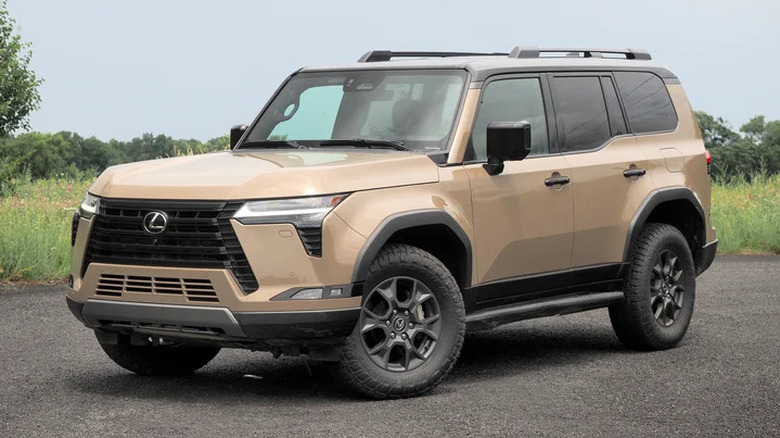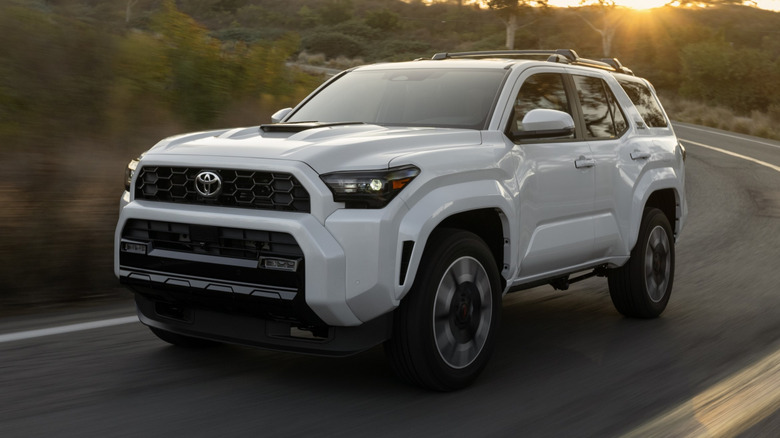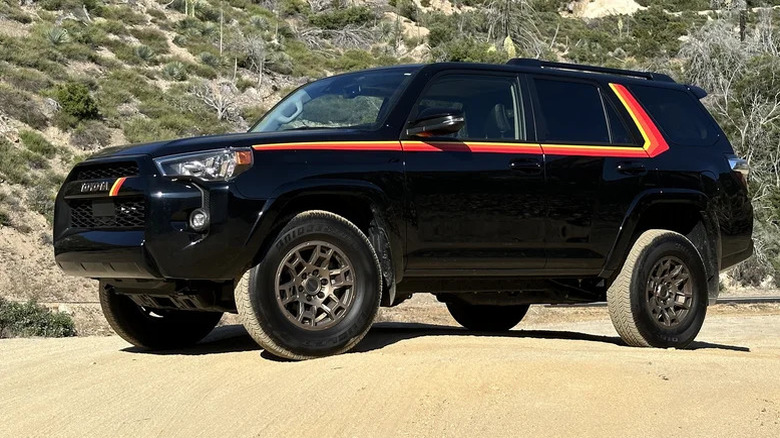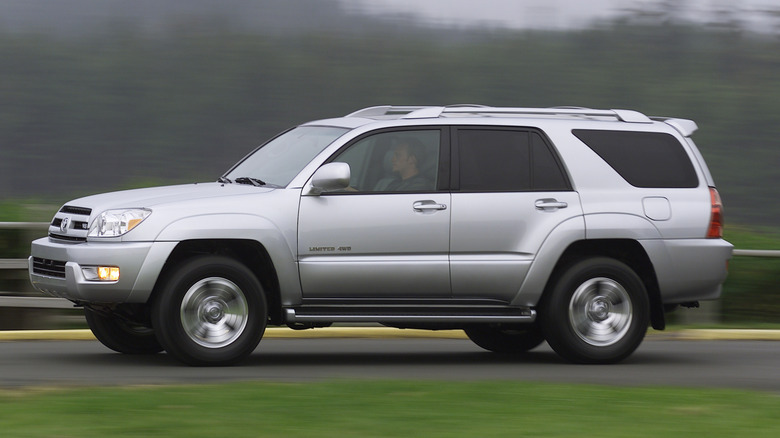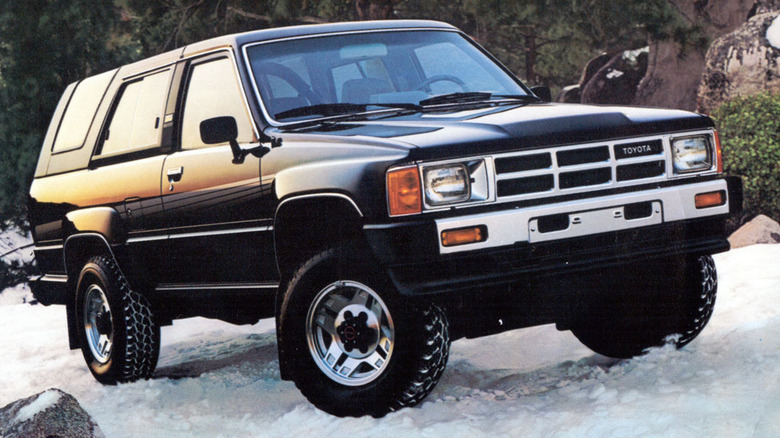Everything To Know Before Buying A Toyota 4Runner (New Or Used)
Most modern SUVs undergo changes every few years to keep them appealing to buyers amid an ever-evolving field of competition, but the Toyota 4Runner isn't like most SUVs. The fifth-generation 4Runner produced until the 2024 model year had barely changed since its introduction in 2010. It seems that Toyota realized it was onto a good thing and stuck with it, but its aging platform and powertrains meant that it couldn't match up to the best SUVs for refinement or efficiency. Thankfully, the Japanese automaker decided it was time to overhaul the car, and released an all-new generation for the 2025 model year.
Despite significant changes, the latest 4Runner keeps its toughness and go-anywhere capabilities. So, is it worth coughing up the cash for a new example or saving some money for an older model year? To help answer that question, we've gathered pricing, value retention, reliability data, and the experience of our review team to assess the SUV's real-world performance. Before you decide whether to buy a new or used 4Runner, it's worth knowing these things first.
The 2025 4Runner starts from $40,770
Toyota offers a wide range of trims for the 2025 4Runner, with the cheapest trim, the SR5, starting from $40,770, excluding fees. Standard features include Toyota's Safety Sense 3.0, which includes lane tracing and road sign assist alongside a radar cruise control. An 8-inch infotainment touchscreen with wireless Apple CarPlay and Android Auto is also standard in base trims, while higher trims come with a 14-inch display.
Lower trims receive Toyota's i-Force four-cylinder powertrain but a second, more potent i-Force MAX powertrain is also available. The cheapest trim with the latter is the $51,990 TRD Off-Road i-Force MAX. Further up the range, the Limited and Platinum trims add the most tech features and sport the plushest cabins, but they come at a significant premium. The Limited starts from $55,400, while the Platinum costs at least $62,860. For the 4Runner's best off-road abilities, buyers should consider the range-topping TRD Pro and Trailhunter trims, which start from $66,900.
Toyota has given the 4Runner a thorough overhaul for 2025
For 2025, Toyota has launched an all-new sixth-generation of the 4Runner, featuring updates throughout the SUV. For example, adjacent to the revised infotainment system is a wireless charging pad with three USB-C charging ports. There's also the 14-speaker JBL audio system in the higher trim models, which incorporates a built-in water-resistant portable speaker. When it's undocked from the car, it can be used like any other portable speaker, at campsites or by the lake or beach. Once docked, it reintegrates with the 4Runner's in-car audio system.
Another new feature available as standard on all 4Runner trims is the Smart Key, which allows a driver's smartphone to function as their vehicle key — meaning your smartphone can open and even start the SUV. The owner can share duplicate digital keys with family or friends for temporary access. To make use of this functionality, owners will need to sign up for a monthly Remote Connect subscription.
The Trailhunter and Platinum trims are new for 2025
In addition to the new features, the 2025 4Runner also launched with two trims that are new to the model. The Trailhunter trim is designed to turn the 4Runner into an adventure-ready overlander from the showroom, doubling down on its all-terrain capability with a set of third-party components that would previously have only been available through the aftermarket. The Trailhunter sports shocks from Old Man Emu, fog lamps by RIGID Industries, and 33-inch tires from Toyo. Plus, Toyota's off-road components feature as standard, including a higher-mounted air intake and an onboard air compressor.
The second new trim available for 2025 is the Platinum, which adds an extra dash of luxury to the go-anywhere SUV. It builds on the features available in the Limited, but also includes exclusive leather-trimmed seats, a head-up display, and heated seats in the second row. Both the Limited and Platinum trims benefit from two new drive modes — Sport S+ and Comfort — that deliver either a sharper drive or a cosseting feel to the car's ride while it's on the road.
The 4Runner's new powertrains are more efficient than before
The launch of the new generation 4Runner has seen the model receive two new powertrains dubbed the i-Force and i-Force MAX. The i-Force is a turbocharged 2.4L four-cylinder engine churning out 278 horsepower and 317 lb-ft of torque and is offered as standard in cheaper 4Runner trims. The i-Force MAX can be found under the hood of various mid- and high-spec trims and combines the same turbocharged 2.4L four-cylinder engine with the assistance of an electric motor. Toyota says it will deliver 326 horsepower and 465 lb-ft of torque.
Both powertrains are more powerful than the 2024 4Runner's 4.0L six-cylinder engine, which produced 270 horsepower and 278 lb-ft of torque. They're both more efficient too — the 2024 model received an EPA rating of 17 mpg combined, while the most frugal 2025 4Runner can hit 22 mpg combined. During highway driving, the EPA reports a return of up to 26 mpg for the newest model.
We found the 2025 4Runner to be highly capable off-road
Given the fifth-generation 4Runner's famed all-terrain prowess, there were always concerns that its replacement might not meet the same high standards. However, after putting the 2025 4Runner through its paces on a Californian ranch, we came away convinced that the 4Runner hadn't lost its off-road chops. Whether it's the overland-oriented Trailhunter, the jump-friendly TRD Pro, or a base-spec model — the new 4Runner can tackle rough terrain with aplomb.
There are clear improvements, too. We found the SUV's on-road manners superior to those of the fifth generation and broadly comparable with other body-on-frame trucks and SUVs. However, neither the 4Runner nor its body-on-frame rivals can match the ride or refinement of a unibody SUV. Any buyers looking to do most of their mileage on asphalt will find better value for money elsewhere in Toyota's range.
Land Cruiser, 4Runner or GX?
Buyers looking for maximum off-road capability and Toyota build quality have several options. While buyers with generous budgets could consider the Sequoia, the most similar SUV to the 4Runner is the Land Cruiser, which is better than the badge. This similarity is not a coincidence — both models share the same platform and the i-Force MAX hybrid powertrain. Pricing for the Land Cruiser starts significantly higher than the 4Runner, at $56,700 excluding fees, but a top-spec Land Cruiser is only slightly pricier than its $61,470 base trim — making the top-spec Land Cruiser cheaper than the 4Runner's Platinum, TRD Pro, and Trailhunter trims.
Complicating things further is the existence of the Lexus GX, a serious SUV that shares a platform with the Toyotas but features a twin-turbocharged 3.4L V6 under the hood. Its interior is more luxurious than both the 4Runner and the Land Cruiser, and it starts slightly cheaper than the TRD Pro and Trailhunter, at $65,585. For the best all-round capability, both on and off the road, that leaves the Lexus as arguably the best value of the trio. Of course, that assumes buyers have $60,000 or so to pony up for their car in the first place — if not, then the base 4Runner's significantly lower starting price still makes it the de facto winner.
The 4Runner holds its value well over time
While the base 4Runner's $40,770 starting price puts it well below the price of the average new car, it's still not exactly a bargain. Buyers on tighter budgets could consider looking for a used example, although the 4Runner's strong retention rate means that even lightly used examples won't be cheap. According to the latest data from KBB, a 2024 4Runner should retain 56.4% of its value after five years on the road. The outlet does not list predicted depreciation data for the 2025 model year, but there's no indication that the retention rate will differ significantly.
That means that buyers of the new 4Runners can rest easy that they own an SUV with one of the best value retention rates in its segment. Used buyers, however, might have to opt for an older model 4Runner to stay within their budget. Luckily, the model's relative lack of change over the last 15 years means buyers won't miss much if they purchase an older model year of the fifth-generation car.
The fifth-generation 4Runner is old-school to a fault
Even when we reviewed the fifth-generation 4Runner in 2016, it seemed old-school. Back then, it had been on the market for six years, and its thirsty V6 engine and lumpy ride made it a notably more dated SUV than its contemporaries. Fast forward to 2023, when we reviewed the 40th Anniversary Edition 4Runner, and it felt ancient. However, it remained a strong seller despite its flaws, due to its tried-and-tested nature and ever-impressive off-road capability.
Buyers looking for a modern, refined SUV can find much better value elsewhere. In fact, most similarly sized SUVs from the last five years probably offer better on-road manners. However, that's not why people continue to buy 4Runners, and so judging the fifth-generation SUV based on its versatility is perhaps to miss the point. It's a deliberately old-school car, complete with accompanying old-school flaws, but that gives it a unique personality in a world of ever-more capable — and ever-more similar — family SUVs.
The 2003 and 2004 model years are worth steering clear of
A key part of the appeal of any older 4Runner is its perceived reliability. In general, the data backs up that perception, with many owners logging impressive mileage with few, if any, problems. However, there have been a few slight blips in the 4Runner's production quality, most notably in the 2003 and 2004 model years. These two models have attracted significantly more owner complaints to the NHTSA than other model years, with 2003 being the worst offender.
The most common complaint for both model years is severe frame corrosion. A significant number of owners reported that the corrosion necessitated costly repairs or even rendered the vehicle unusable. Given the issue's prevalence, buyers considering a 4Runner from the affected model years should thoroughly inspect the vehicle for corrosion before they buy or, ideally, avoid the most troublesome model years altogether.
The first-generation 4Runner debuted in 1984
Even if buyers choose to avoid a few 4Runner model years because of rust-related reliability concerns, they'll still have a plethora of examples to choose from. The 4Runner has been in production for more than four decades, with the first examples launching in 1984. On average, first-generation 4Runners sell for around $19,000, although the cheapest examples can be picked up for a few thousand bucks. The second-generation 4Runner launched in 1990 and is markedly cheaper, with an average resale price of around $13,000.
The third-generation 4Runner arrived in 1996 and brought a revised set of powertrains and modern styling, plus a wider range of upmarket features in its top-spec trims. Prices for third-generation examples vary considerably based on mileage and condition, but the average resale price sits just under $16,000. The 2003 model saw the launch of the fourth generation, which, among other things, introduced the 4.0L V6 engine that powered 4Runners until 2024. The fifth, penultimate generation hit dealerships for the 2010 model year.
